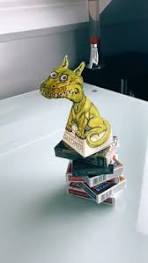Unveiling the Mystical World of Dragon Optical Illusions
The Enchanting World of Dragon Optical Illusions
Dragons have long captured the imagination of people around the world with their majestic presence and mythical allure. But what if I told you that you could experience the magic of dragons in a whole new way through optical illusions?
Dragon optical illusions are a fascinating form of visual trickery that play with our perception and challenge our sense of reality. By cleverly manipulating shapes, colours, and patterns, artists create stunning images that appear to depict dragons in all their fiery glory.
One popular type of dragon optical illusion involves using intricate designs to create the illusion of a dragon hidden within the artwork. At first glance, you may see nothing more than a jumble of lines and shapes. But take a closer look, and suddenly a fearsome dragon emerges from the chaos, ready to breathe fire and take flight.
Another type of dragon optical illusion utilises the concept of depth perception to make it seem as though a dragon is leaping out from the page or screen towards you. Through skilful shading and perspective techniques, artists bring these mythical creatures to life in a way that feels almost tangible.
Whether you’re a fan of dragons or simply enjoy mind-bending visual puzzles, exploring the world of dragon optical illusions is sure to ignite your sense of wonder and spark your imagination. So why not embark on a journey into this enchanting realm where reality blends seamlessly with fantasy?
Prepare to be mesmerised by the beauty and mystery of dragon optical illusions as they transport you to a realm where magic reigns supreme and the impossible becomes possible.
Exploring the Mysteries of Optical Illusions: Understanding the Dragon and T-Rex Phenomena
- How does the dragon illusion work?
- Who made the dragon illusion?
- Why does the T-rex illusion work?
- What are the 3 main optical illusions?
How does the dragon illusion work?
The dragon illusion captivates viewers by cleverly manipulating visual cues to create the striking impression of a three-dimensional dragon seemingly coming to life. This optical illusion works through the strategic placement of cut-out shapes and precise alignment, allowing the viewer’s brain to interpret the flat image as a dynamic, moving creature. By exploiting our brain’s tendency to perceive depth and movement based on visual cues, such as shading and perspective, the dragon illusion tricks our perception into believing in the existence of a fantastical beast that defies reality.
Who made the dragon illusion?
The creation of the dragon illusion, a popular and captivating optical phenomenon, is often attributed to the Japanese artist and inventor Kokichi Sugihara. Sugihara’s innovative work in the field of optical illusions has garnered international acclaim for its creativity and ingenuity. Through his mastery of geometry and perspective, Sugihara has brought to life a mesmerising dragon illusion that continues to intrigue and delight viewers around the world.
Why does the T-rex illusion work?
The T-rex illusion, also known as the dragon illusion, captivates viewers due to a clever manipulation of perspective and depth perception. This optical illusion exploits our brain’s tendency to interpret two-dimensional images as three-dimensional objects. When viewing the specially designed template from a specific angle, the flat image of a dragon or T-rex appears to come alive and turn its head to follow the viewer’s movements. This captivating effect tricks our visual system into perceiving motion where none actually exists, creating a thrilling and immersive experience that challenges our understanding of reality.
What are the 3 main optical illusions?
When exploring the captivating realm of optical illusions, one frequently asked question revolves around the identification of the three main types. The first is the famous “Müller-Lyer illusion,” where lines with arrow-like tails appear to be different lengths despite being identical. Next, the “Ponzo illusion” tricks our brains into perceiving two identical lines as different lengths due to surrounding context. Lastly, the “Ebbinghaus illusion” showcases how our perception of an object’s size can be influenced by surrounding elements, such as larger circles making a central circle appear smaller. These three optical illusions exemplify the fascinating ways in which our minds can be deceived by visual stimuli.


